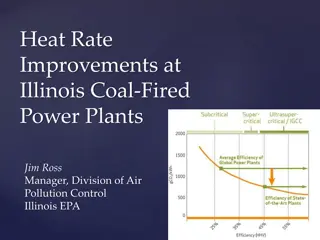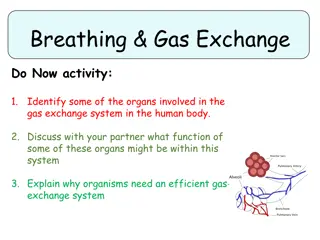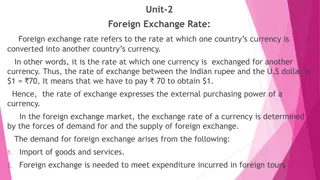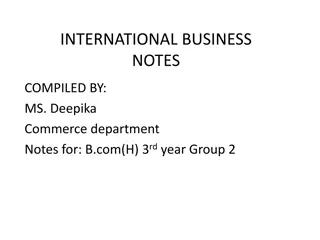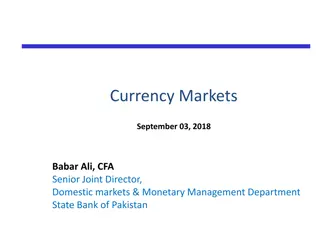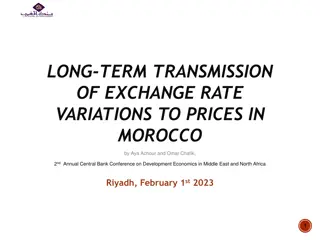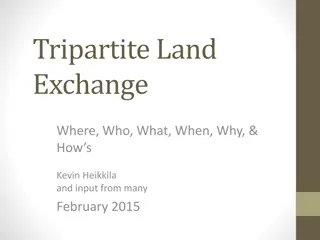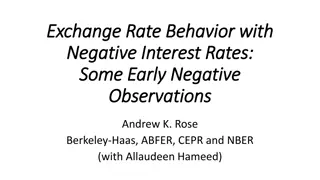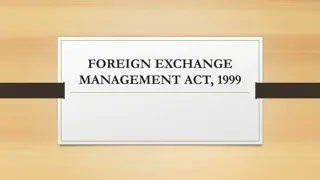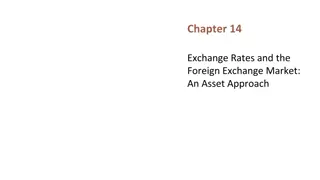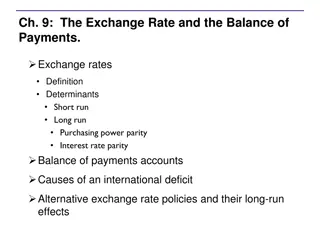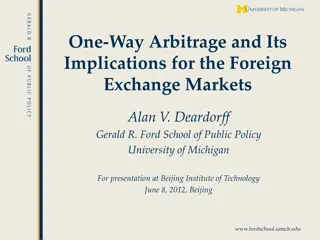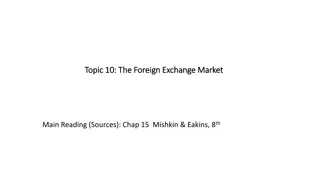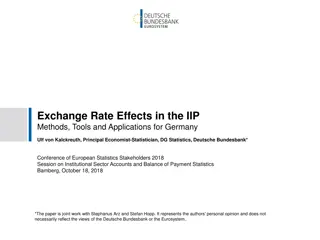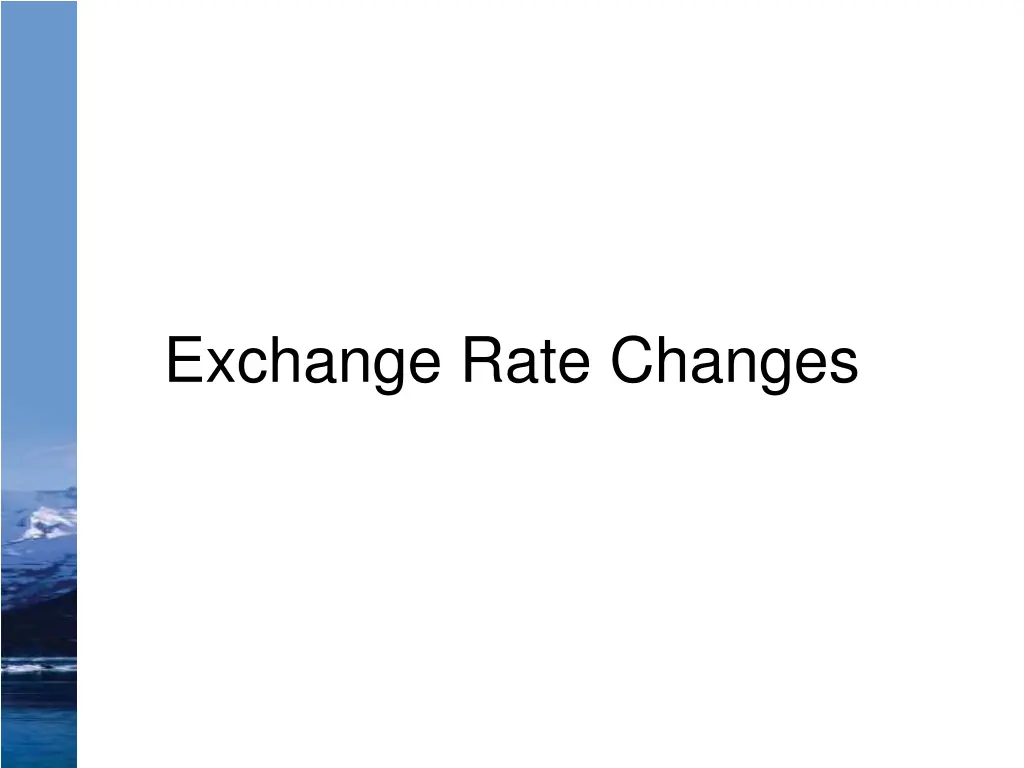
Understanding Exchange Rate Movements
Gain insights into how exchange rate movements are measured, the impact of demand and supply on exchange rates, and the economic factors influencing changes in exchange rates. Explore concepts like freely floating exchange rates, pegged currencies, and more.
Download Presentation

Please find below an Image/Link to download the presentation.
The content on the website is provided AS IS for your information and personal use only. It may not be sold, licensed, or shared on other websites without obtaining consent from the author. If you encounter any issues during the download, it is possible that the publisher has removed the file from their server.
You are allowed to download the files provided on this website for personal or commercial use, subject to the condition that they are used lawfully. All files are the property of their respective owners.
The content on the website is provided AS IS for your information and personal use only. It may not be sold, licensed, or shared on other websites without obtaining consent from the author.
E N D
Presentation Transcript
Lecture Objectives To explain how exchange rate movements are measured; To explain the effect of demand and supply on exchange rates and; To examine a range of economic and market factors which may explain changes in the exchange rate.
Understanding Exchange Rates Economic activity is globally unified today to an unprecedented degree Changes in one nation s economy are rapidly transmitted to that nation s trading partners These fluctuations in economic activity are reflected almost immediately, in fluctuations in currency values
Some concepts Freely floating exchange rate- absence of government intervention, value is set by market forces Pegged currency- one whose value is set by the government Devaluation- decrease in the stated par value of a pegged currency Appreciation if one currency gains value in respect to the other Revaluation- increase in par value of a pegged currency Depreciation- loses value
Measuring Exchange Rate Movements An exchange rate measures the value of one currency in units of another currency. When a currency declines in value, it is said to depreciate. When it increases in value, it is said to appreciate. On the days when some currencies appreciate while others depreciate against a particular currency, that currency is said to be mixed in trading.
Measuring Exchange Rate Movements Exchange rate can be for spot or forward delivery A forward rate is the price at which foreign exchange is quoted for delivery at a specified future date. The foreign exchange market where currencies are traded, is not a physical place; rather, it is an electronically linked network of banks, foreign exchange brokers, and dealers whose function is to bring together buyers and sellers of foreign exchange
Measuring Exchange Rate Movements When a foreign currency s spot rates are compared at two specific points in time, the spot rate at the more recent date is denoted as St and the spot rate at the earlier date is denoted as St-1. The percentage change in the value of the foreign currency is computed as follows:
Annual Changes in the Value of the Euro Date Exchange Rate Annual % 1/1/2000 1/1/2001 1/1/2002 1/1/2003 1/1/2004 $1.001/ $0.94/ $0.89/ $1.05/ $1.26/ 6.1% 5.3% +18.0% +20.0%
Exchange rate movements Demand for a currency- When dollar is expensive, say 0.62/$, there will be low demand for dollars to buy US goods and invest in the US When dollar is cheap, say, 0.57/$, there will be high demand for dollars to buy US goods and invest in the USA
Exchange rate movements Supply of a currency- When dollar is expensive say, 0.62/$, there will be low demand for dollars to buy US goods and invest in the US. But UK goods will be cheaper compared to dollars. Hence supply of dollars to buy UK goods will increase. When dollar is cheap say, 0.57/$, there will be high demand for dollars to buy US goods and invest in the US. But UK goods will be expensive compared to dollars. Hence supply of dollars to buy UK goods will decrease.
Equilibrium At an exchange rate of 0.57/$, the quantity of dollar demanded would exceed the supply of dollars for sale. Consequently banks providing foreign exchange services would experience a shortage of dollars at that exchange rate At an exchange rate of 0.62/$, the quantity of dollar demanded would be less the supply of dollars for sale. Consequently banks providing foreign exchange services would experience a surplus of dollars at that exchange rate The equilibrium exchange rate, 0.60/$, where quantities of dollar demanded is equal to the supply of dollars
Factors that Influence Exchange Rates ( ) = INF INT INC GC EXP e f , , , , e =percentage change in the spot rate Greek letter delta stands for difference or change INF = change in the relative inflation rate INT = change in the relative interest rate INC = change in the relative income level GC = change in government controls EXP = change in expectations of future exchange rates
Factors that Influence Exchange Rates Relative Inflation Rates U.K. inflation while US inflation remains unchanged U.K. demand for US goods, and hence demand for $ . US desire for U.K. goods, and hence the supply of $ Upward pressure on dollars and new equilibrium is 0.61/$ $ price S1 S0 0.611 0.60 D1 D0 Quantity of $
Factors that Influence Exchange Rates Relative Interest Rates U.K. interest rates while US interest rate remains unchanged U.K. demand for US bank deposits, and hence demand for $ since UK rates are more attractive. $ price S0 S1 0.61/$ 0.60/$ US desire for British bank deposits, and hence the supply of $ Downward pressure on dollars and new equilibrium is 0.60/$ D0 D1 Quantity of $
Factors that Influence Exchange Rates Relative Interest Rates A relatively high interest rate may actually reflect expectations of relatively high inflation, which may discourage foreign investment. It is thus useful to consider the real interest rate, which adjusts the nominal interest rate for inflation.
Factors that Influence Exchange Rates Relative Interest Rates real nominal interest interest inflation rate rate rate This relationship is sometimes called the Fisher effect. The US investor should only invest in the UK is he/she feels that the interest rate less inflation i.e. the real interest rate is going to be higher in the UK than in the US
So what does the Fisher analysis mean at an international level? Country A Country B comment Factor Time preference + Risk 1 % 1 % No reason for there to be a difference 1% 1% We choose investments in each country that have low risk Real rates should be the same Different economic policies are inevitable The difference in inflation rates explains the difference in interest rates! 2 % 2 % = Real rate 4 % 2 % + inflation 7% 5% = interest rate
Factors that Influence Exchange Rates Relative Income Levels U.K. income level while US income level remains unchanged U.K. demand for US goods, and hence $. No expected change for the supply of $ as US income level is constant The equilibrium exchange rate and value of the dollar are expected to rise. /$ S ,S1 r1 0 r0 D1 D0 Quantity of $
Factors that Influence Exchange Rates Government Controls Governments may influence the equilibrium exchange rate by: imposing foreign exchange barriers, imposing foreign trade barriers, intervening in the foreign exchange market, and affecting macro variables such as inflation, interest rates, and income levels.
Factors that Influence Exchange Rates Suppose US real interest rose relative to British real interest rates. The expected reaction would be an increase in the British supply of pounds for sale to obtain more US dollars (in order to capitalize on high money market yields). But if UK government placed a heavy tax on interest of income earned from foreign investments, this could discourage the exchange of pounds for dollars.
Factors that Influence Exchange Rates Expectations Foreign exchange markets react to any news that may have a future effect. News of a potential surge in U.S. inflation may cause currency traders to sell dollars anticipating a decline in dollar s value. But if high inflation is less than expected then traders may buy dollars as the the situation is better than at first thought. If inflation is in line with market expectation there may be no change in dollar value. So high inflation may have positive, negative or no effect on dollar value Many institutional investors take currency positions based on anticipated interest rate movements in various countries.
Factors that Influence Exchange Rates Expectations Economic signals that affect exchange rates can change quickly, such that speculators may overreact initially and then find that they have to make a correction. Speculation on the currencies of emerging markets can have a substantial impact on their exchange rates.
Factors that Influence Exchange Rates Relative economic growth rates A nation with strong economic growth will attract investment capital seeking to acquire domestic assets The demand for domestic assets will lead to an increased demand for the domestic currency and a stronger currency Nations with poor growth prospect will see an exodus of capital and weaker currencies
Factors that Influence Exchange Rates Political and Economic Risk Investors prefer to hold lesser amounts of riskier assets; thus, low-risk currencies those associated with more politically and economically stable nations are highly valued than high-risk currencies
Factors that Influence Exchange Rates Interaction of Factors The various factors sometimes interact and simultaneously affect exchange rate movements. For example, an increase in income levels sometimes causes expectations of higher interest rates, thus placing opposing pressures on foreign currency values. Higher income can result in more imports Higher interest rates can attract financial inflows Favourable financial inflows can overwhelm un-favourable trade flows Hence increase in income may strengthen local currency
Speculating on Anticipated Exchange Rates London Bank expects the exchange rate of the New Zealand dollar to appreciate against the from its present level of 0.35 to 0.38 in 30 days. Borrows at 7.20% for 30 days 4. Holds 21,831,543 1. Borrows 20 m Repays 20,120,000 A profit of 21,831,543 20,120,000 = 1,711,543 Exchange at 0.38/NZ$ Exchange at 0.35/NZ$ Lends at 6.48% for 30 days 2. Holds NZ$57,142,857 3. Receives NZ$57,451,428
Speculating on Anticipated Exchange Rates London Bank expects the exchange rate of the New Zealand dollar to depreciate from its present level of 0.50 euros to 0.48 euros in 30 days. Borrows at 6.96% for 30 days 1. Borrows NZ$40 million 4. Holds NZ$41,900,000 Returns NZ$40,232,000 Profit of NZ$1,668,000 or 800,640 euros Exchange at 0.48 euros/NZ$ Exchange at 0.50 euros/NZ$ Lends at 6.72% for 30 days 3. Receives 20,112,000 euros 2. Holds 20 m euros
Speculating on Anticipated Exchange Rates Between 2 currencies borrow in the weaker currency and invest in the stronger currency providing that the interest rate difference is not too adverse Exchange rates are very volatile, and a poor forecast can result in a large loss. One well-known bank failure, Franklin National Bank in 1974, was primarily attributed to massive speculative losses from foreign currency positions.


